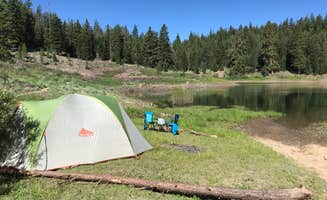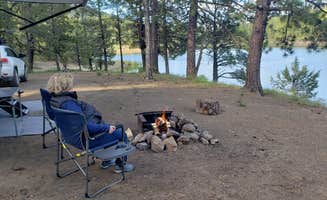Tent campsites near Adel, Oregon range from 4,500 to 7,000 feet in elevation, creating distinct seasonal camping conditions across the region. Summer temperatures typically range from 45°F at night to 85°F during peak daytime hours. Most campgrounds remain inaccessible until snow melts in late spring, with forest service roads often requiring high-clearance vehicles due to minimal maintenance.
What to do
Fishing at stocked waters: Holbrook Reservoir Forest Camp offers freshly stocked fishing opportunities with multiple species. "When we were there in early June, the reservoir had been stocked. Although we are not fisher folks, we enjoyed the birds that were enjoying the fish: white pelicans, ospreys, Buffleheads, Double-crested Cormorants, and a Bald Eagle," notes camper James.
Spring exploration: Clear Spring Forest Camp provides direct access to natural water sources. "The fresh water spring is not a 1/4" mile but just across the road where it has easy access through a pipe flowing into a small pool. Tons of flow and I found the water pure and clean," reports Brad S.
Waterfront camping: Several campgrounds offer direct lake access for summer recreation. At Holbrook Reservoir, one camper advises, "Don't just stop at the first section like we did, there are sites along the back of the lake too, go past the 1st lot with the bathrooms (don't take the sand road, take the next right after that) and follow until you find a site you like."
What campers like
Private beach access: Happy Camp features secluded waterfront sites along Dairy Creek. According to Brad S., "Site at the far back to the right is far and away the best with it's own beach on the river."
Wildlife observation: Dairy Creek hosts notable beaver populations visible from campgrounds. "Lots of beaver activity nearby and could hear them thumping in the evening," reports a Happy Camp visitor.
Natural water sources: Several campgrounds feature flowing springs for filtering water. At Clear Spring Forest Camp, campers appreciate "lovely locations with a couple spots to put your tent right next to Dairy Creek."
What you should know
Mosquito preparation: Waterfront sites require insect protection, particularly in early summer. One Holbrook Reservoir camper notes, "Lots of mosquitoes but worth it. Sites were large and toilets were clean."
Road conditions: Access roads deteriorate significantly after rain or during snowmelt. Cave Lake Campground requires particular caution as one visitor warns, "Difficult climb/drive without good tires or 4WD (very steep, high grade road that is mostly dirt and large rocks)."
Cell service limitations: Communication options are virtually nonexistent at most campsites. As James mentions about Holbrook Reservoir, "It is fairly remote with no cell phone coverage."
Tips for camping with families
Site selection strategy: At larger campgrounds, explore all camping areas before choosing. "The main campsite sits at the south end of the reservoir near the small dam. It has a boat ramp, a picnic table and a toilet. On the west side of the reservoir there are two different areas with at least one of them having a pit toilet," explains James at Holbrook Reservoir.
Water safety planning: Campsites near water require close supervision for children. Most sites with water access lack designated swimming areas or safety features.
Wildlife viewing opportunities: Several campgrounds offer educational opportunities to observe beaver dams, bird migrations and fishing behavior. Cave Lake Campground campers report "stunning views of surrounding mountains and forest with a crystal clear lake for swimming and fishing."
Tips from RVers
Length restrictions: Most campgrounds accommodate smaller RVs under 25 feet but have limited turning radius. At Holbrook Reservoir, a camper notes, "We were able to park our 20 foot trailer near the lake. The roads coming in are pretty typical forest service type roads requiring you to go fairly slowly and watch out for potholes."
Tire preparation: Access roads require reinforced tires and potential repair equipment. A Cave Lake visitor cautions, "4WD/AWD is a must. And drive slowly. We popped a tire in our SUV on the way up, but totally worth it."
Site leveling challenges: Most primitive campsites lack graded or level parking areas. RVers should bring leveling blocks and stabilizers for extended stays.



